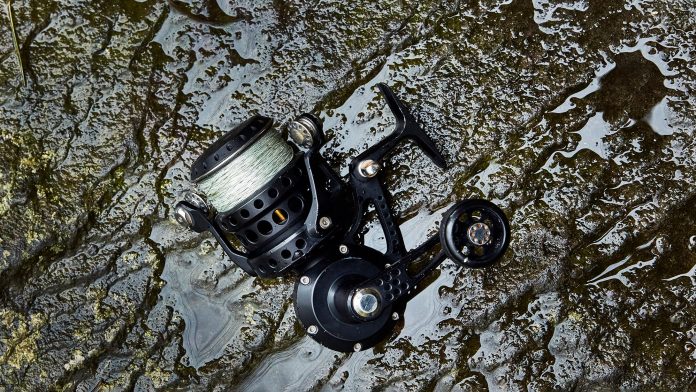We may earn revenue from the products available on this page and participate in affiliate programs. Learn more ›
THE REEL ARRIVED in a handcrafted wooden box with a shiny silver Z screwed to the top. Inside, the ZX2’s body was cradled in a custom compartment, the detached handle secured in its own nook by a leather strap. The way it was presented reminded me of a limited-edition pistol, which was fitting because this spinning reel, with its sharp machining and matte-black anodized finish, looked like a tactical weapon. I glanced at the serial number on the side plate—number 105 off the line.
In 2005, Zeebaas emerged as the first competitor to Van Staal, which at the time made the most expensive spinning reel ever produced, with a price tag north of $1,000. For many years, Van Staal reels were more a status symbol than anything, but as the striped bass population roared back in the late 1990s, they became the gold standard of diehard surf-casters that put their gear through hell. With no bail to break, a sealed drag and body, and solid-stock aluminum construction, you could bang a Van Staal off jetty rocks, or dunk it in the sand and salt, and it would keep on ticking. Back then I was a surf-obsessed assistant editor at Salt Water Sportsman, so when the chance came to check out a rival Zeebaas—a reel that 22-year-old me could never have afforded—I jumped.
Eighteen years later, I couldn’t tell you where that box ended up, but I always know exactly where the reel is. The folks at Zeebaas were nice enough to let me hold on to it, and since then, countless other spinners have broken or been tossed into cabinets, but the ZX2 has been front and center on deck.
My first serious outing with the reel was in Montauk, New York, where a buddy and I split a dirt-cheap motel room in the surf-casting mecca. The place didn’t have a hose outside. So for five nights straight, that reel was blasted by salt spray and laid on the sand without a rinse, and yet it never so much as sputtered. After that, it became my only surf reel and put hundreds of stripers on the sand.
But then I did something silly and bought a boat. Each year afterward, I’d push the 1983 Pursuit a little farther offshore, and the Zeebaas never missed a trip. It fought mahi-mahi and brown sharks. When throwing poppers at tuna became fashionable, I couldn’t afford a bigger offshore spinning reel, so I used the ZX2, which put my first popped yellowfins and bluefins on deck without a hiccup. It had the guts to beat fish outside its weight class, but more than anything it was reliable. It may have been overkill for Niagara River lake trout, and sweet-water striped bass on the Delaware River, and pike in Canada, but it earned a chance to catch them all simply because I knew it wouldn’t let me down.
Today, it’s chipped, dinged, and scarred, but it’s still the first reel I grab for big-fish pursuits. Never once since I’ve owned the ZX2 has it been serviced. I’ve never had it resealed, cleaned, or re-greased. While I don’t recommend doing that (and neither does the company), name a spinning reel that costs less than $600 that would have a prayer of being abused for nearly 20 years without ever needing a tuneup. People often scoff at the price tags of Zeebaas and Van Staal reels, but in a time when it feels like things are so disposable, it’s hard to argue that you get what you pay for with most things. But I’ll say this: Now that I can afford a Zeebaas, I’d buy another in a heartbeat—except it doesn’t seem like I’ll ever need to.
Read more F&S+ stories.








